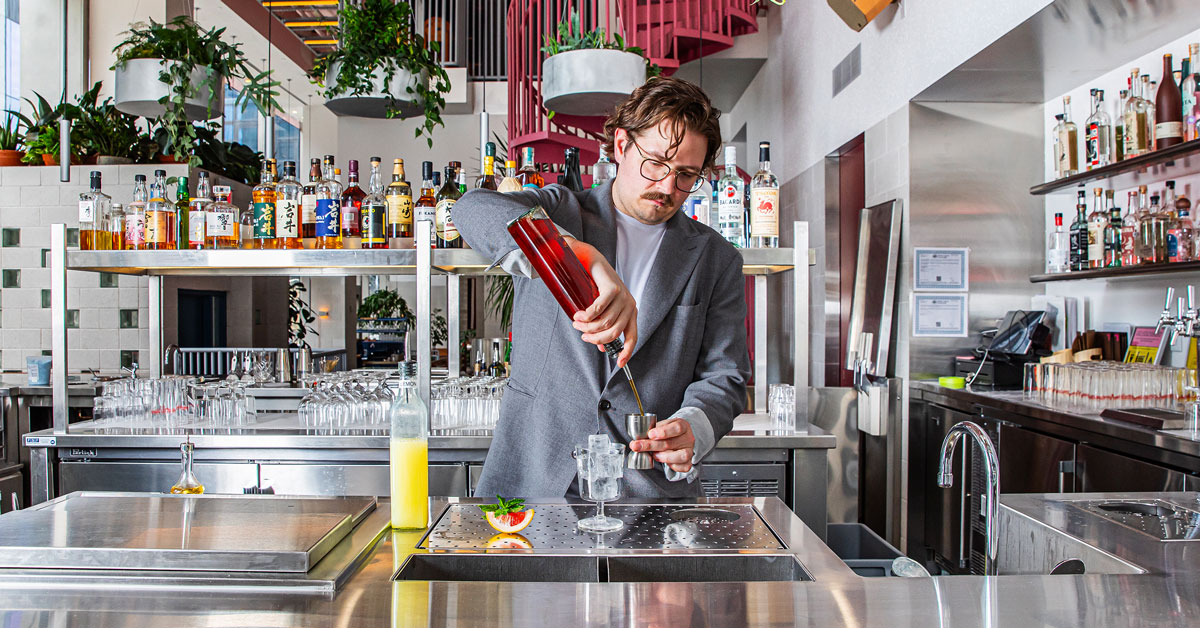
Tres Monos has been lauded as one of Buenos Aires’—not to mention the world’s—best places to grab a cocktail. The bar, co-owner Charly Aguinsky tells me, is not just a bar: It’s a three-part system involving, yes, a cocktail bar, but also a hospitality school and a consultancy group for coffee shops, restaurants and more. It’s a lot of spinning plates, but Tres Monos isn’t one to back away from a challenge.
The team’s latest challenge? Developing a menu for a new opening from a celebrated restaurant group. The catch? The new spot, Papa San, is 5,000 miles away in New York City.
After receiving a fateful email from Juan Correa and Erik Ramirez of the Llama Group of restaurants in 2022, Aguinsky and his team spent the next few years in R&D mode: pulling inspiration from the Japanese izakayas and Peruvian cuisine Papa San hoped to channel, traveling to New York regularly to demo and discuss the drinks and training a brand-new bar staff.
At a time when restaurants—including those in the Llama Group—are making some of the best cocktails, it may come as a surprise that Papa San would outsource the drink development from so far away. But the partnership put the New York team on to Latin ingredients that are lesser-known stateside, and connected them to the bartenders behind a world-class hospitality training program. The menu, which highlights everything from Peruvian olives and peppers to Argentina’s favorite amaro, is a reflection of that vision.
Here, Aguinsky shares in his own words how Tres Monos and Papa San collaborated across continents.

We’ve been involved since the beginning, from the planning and the timing to the collection of the spirits, the cocktails and the training. We knew the Llama Group because we’d been to New York multiple times, and we have friends in the industry who had mentioned the restaurants. We’d never met [co-owners] Juan [Correa] or Erik [Ramirez] personally. They introduced themselves [over email] as a Latin, Peruvian group that was trying to build a new restaurant. Since then, we started working together. Obviously, we knew that in New York, everything takes time, especially a big restaurant in Manhattan. So we met each other [in person] almost two years ago when they visited us in Buenos Aires, and we visit New York every 45 to 50 days.
From there, we started building a proposal, working with cocktails we already knew that worked [in our own bar] and developing new ones exclusively for the restaurant. That research and development phase lasted around six months, gathering 30-plus recipes. Then we had tastings with the owners to better understand what they wanted for our drinks. From there, we chose 15, and from those, we started perfecting and [incorporating] the ingredients Chef Erik was going to use in the kitchen.

A couple of weeks before opening, we visited, and the focus of our trip was to train the staff. Usually when we train a team, especially a new one, we focus on two different pillars. On one hand, we have the production and prep that happens back-of-house. All of the cooking, clarifying, fermentation, maceration—a bar works pretty much like a kitchen, and for us, there’s a lot of work that goes into that. On the other hand, it’s proper training with the bartenders, both in our cocktails and the classic cocktails: Negronis, Old-Fashioneds, Gin & Tonics, Margaritas.
[Now that Papa San is open,] we have weekly calls with the head bartender and team to see what’s going on in the restaurant and how services are going. We’re obviously not based in New York, but we go about every two months.
Papa San has only been open for about a month, but with the upcoming spring and summer season, we’re developing new recipes. Also, by the end of April, we’re going to begin brunch services. It’s going to be a bit different from a service perspective, so we’re developing a different proposal for brunch, one that’s more relaxed.
For us, [collaborating with the kitchen] is really important. One reason is so that the cocktails that you have at Papa San are unique to the place. Also, it helps with leftovers. When [the bar] can use ingredients the kitchen already uses, that’s smart business.
For example, we have a clarified cocktail called Golden Curry. It has Japanese whisky, vanilla and, at Tres Monos, we use curry spices. When we tried it with Erik, we realized we could do a twist on the recipe by including the curry they use in some of [Papa San’s] dishes. It’s made with aji amarillo (a yellow pepper from Peru) and salsa tres chiles, which the kitchen uses as part of a sauce.
The Misticollins is a twist on a mezcal or tequila and tonic. On another one of our trips to New York, we tried Alfonso olives, which are the big, purple olives from Peru, and we were amazed by the flavor and instantly knew it could work in the recipe. We ended up putting it in a mezcal-based drink with sake and Japanese cucumber, for a Japanese profile.
All the cocktails that are on the menu have either Peruvian or Latin or Japanese ingredients, and sometimes all three. We are a Latin bar that wants to show that we can be fun as well. It’s not just pouring ice-cold Martinis without any personality. We showcase what is going on in Peru, Argentina and the rest of Latin America, and that, for us, is something special.
This interview has been edited and condensed for clarity.







